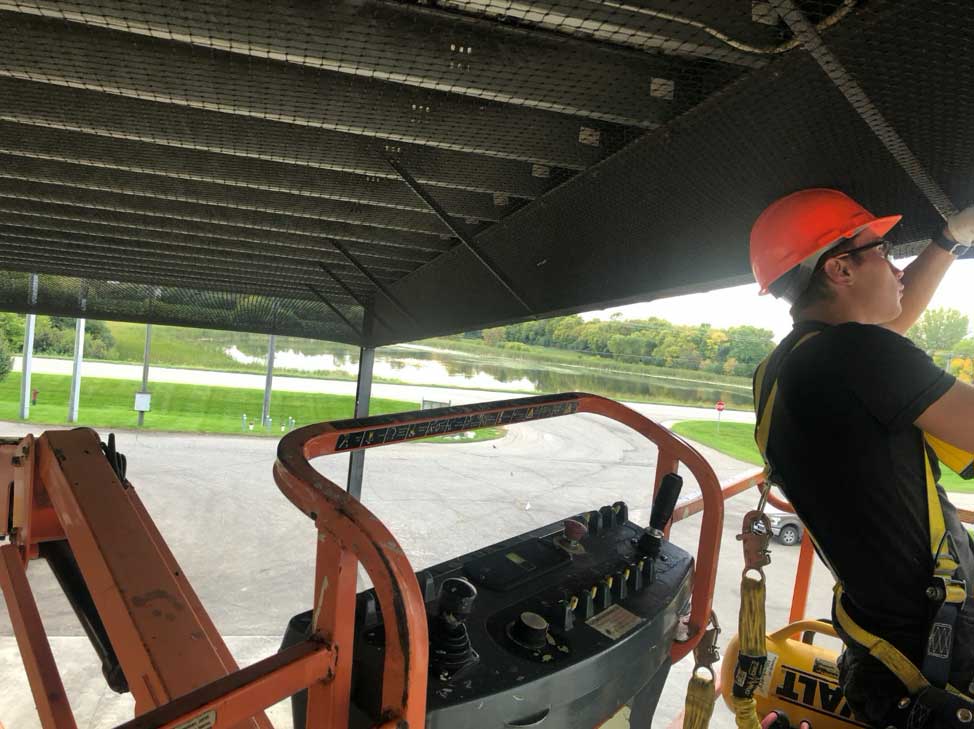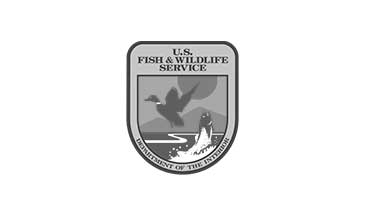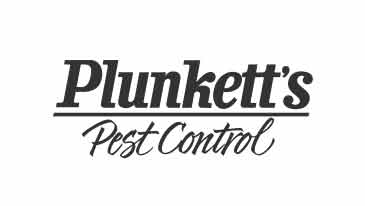Nuisance Bird Control - Pest Birds
Pigeon, Starling, and Sparrow Control
Trust the pros at Varment Guard to handle any of your pest bird problems. Our expert technicians will create a customized plan for your specific pest bird issues.
Our control method options consists of habitat modification, exclusion, bird harassment or intimidation, repellents, deterrents and barriers, bird removal, baits and more.
Contact Varment Guard Wildlife Services today!
PIGEON BIOLOGY
- Adult body length: 11 inches
- Adult body weight: 13 ounces
- Egg incubation period: 17 to 19 days
- Broods per year: Several
- Brood size: 1 to 2 eggs (usually 2) per clutch
- Birthing Period: Peak in spring and summer
- Age at which young leave nest: 4 to 6 weeks
- Activity seasonality: year-round
- Primary diet: Seeds, grain, livestock feed, livestock manure, discarded food
PIGEON DAMAGE
The feral pigeon adapts well to urban environments and is the most troublesome bird pest in urban settings as well as in small rural communities. The abundance of shelter provided by the design of many buildings assures that pigeons will have ample places to roost, loaf, and nest. Food and water is often in adequate supply, but when it isn’t, the birds seek these necessities from nearby rural or undeveloped areas which are generally within flight range. Pigeon droppings deface and accelerate deterioration of statues, buildings, and equipment and foul areas where people may walk or work. Pigeon droppings and nests clog gutter downspouts and air intakes, mar window sills, and render fire escapes hazardous. Their droppings and feathers can contaminate large quantities of livestock feed and food destined for human consumption. The serious and constant public health problems they create are unmatched by any other bird species. They are known to carry or transmit pigeon ornithosis, encephalitis, Newcastle disease, histoplasmosis, cryptococcosis, toxoplasmosis, pseudo-tuberculosis, pigeon coccidiosis, and salmonella food poisoning. Pigeon ectoparasites include a number of bugs, fleas, ticks, and mites, some of which bite people (e.g., northern fowl mite).
STARLING BIOLOGY
- Adult body length: 7 1/2 to 8 1/2 inches
- Adult body weight: 2 1/2 to 3 1/2 ounces
- Egg incubation period: 11 to 14 days
- Broods per year: 2
- Brood size: 2 to 8 eggs (usually 4 to 6) per clutch
- Birthing Period: Spring and summer
- Age at which young leave nest: 3 to 4 weeks
- Activity seasonality: Year-round
- Primary diet: Fruits, seeds, grain, insects, livestock feed, discarded food
STARLING DAMAGE & HEALTH RISKS
Starlings are disliked in urbanized settings because of their raucous vocalizations made at roosting time and because of the filth (e.g., feces and nesting materials) they leave behind. Starlings create problems nesting on or in buildings . Starlings have adapted well to cities and suburbs where they utilize a multitude of roosting sites, including building ledges, lighted signs, marquees, billboard bracing, hollow lamp posts, soffits, as well as dryer and stove exhaust ducts and vents. In residential settings, nesting in bathroom, stove, and dryer exhaust vents is the type of starling activity most homeowners will experience. Blocked exhaust vents can cause moisture and odor problems. Issues with blocked dryer vents include clothes taking longer to dry and the potential fire risk. Unprotected ridge vents allow starlings into the attic space to build nests. Starlings add to their nests year after year, so nests in the attic can become quite large.
Starlings can form large flocks into the thousands, overwhelming an area with noise from vocalizations and feces on buildings, cars, and walkways. Not only are these large flocks obnoxious to the senses, but the birds are known to transmit diseases such as encephalitis, ornithosis, and histoplasmosis. Starlings, in addition to consuming large amounts of poultry, hog, and cattle feed, are implicated in the spread of diseases of livestock (e.g., hog cholera) via fecal contamination. More costly damage is inflicted by hungry starlings on cereal, fruit, and vegetable crops in agricultural, orchard and garden settings.
Looking for a bird control specialist near you? Contact Varment Guard's bird control specialists today!
SPARROW
Common names:
- House Sparrow / English Sparrow
Scientific name:
- Passer domesticus
BIOLOGY
- Adult body length: 5 to 6 inches
- Adult body weight: about 1 ounce
- Egg incubation period: 10 to 17 days
- Broods per year: 2 to 5
- Brood size: 3 to 9 eggs (usually 5 to 6) per clutch
- Birthing Period: March through August
- Age at which young leave nest: 3 weeks
- Activity seasonality: Year-round
- Primary diet: Fruits, seeds, grain, insects, livestock feed, discarded food
SPARROW DAMAGE
House sparrow nests, comprised of twigs, grass, paper, and string, are built in gutters, vents, soffits, lamp poles, on rafters, building ledges, and almost any other conceivable elevated, sheltered spot. They frequently build their unsightly nests inside warehouses, airport hangars, and under stadium roofs. The prolific house sparrow has become largely dependent on humans for both food sources and nesting sites. In addition to their messy nests and the contamination and defacement caused by droppings, sparrows damage rigid foam board and other soft insulation in warehouses and in poultry and hog-raising facilities. In electrical substations, their nests have been known to cause short circuits and fires. Their nesting, roosting, and feeding activities may all contribute to the sparrow’s pest status. House sparrows are implicated in the transmission of more than 25 diseases to humans and domestic animals (Weber 1979) including psittacosis, salmonellosis, and several forms of encephalitis. Sparrows in and around poultry and hog farms, because of their disease-carrying potential, are of particular concern to farmers. Beside the diseases they may transmit, a number of ectoparasites (e.g., northern fowl mite) are associated with the bird and its nests.
We can rid you of any bird problems safely and efficiently!
Bird Control Methods:
HABITAT MODIFICATION AND SANITATION
Good sanitation practices, such as removal of spilled food or refuse, can do much to reduce the attractiveness of an area to pigeons, starlings and sparrows. This depends on the situation and whether or not the food source can be effectively and economically limited. The removal of nests and nest sites also may be included as part of a sanitation program. Habitat modification is sometimes of value where starlings are roosting in street or park trees. Selective pruning of smaller, inner perching branches to open up the canopy of the trees may make them unsuitable for roosting cover. Sparrow nests in vine-covered buildings can be difficult to locate and remove. Consideration should be given to radically trimming vines or removing them. All nests that are knocked down should be cleaned up and destroyed to prevent the birds from reusing the material and to prevent the spread of nest parasites.
EXCLUSION & PREVENTION

The best permanent solution to nuisance birds that roost or nest in or on buildings is to “build them out” by making the site bird-proof. This is easily said but often difficult to accomplish. Building porticoes and balconies, exposed rafters on overhanging dock roofs, bridge bracings and other large, sheltered and recessed expanses, can be excluded using fine mesh plastic and polyethylene bird netting. Smaller recessed areas in structures (e.g., dormer corners and louvers of intake vents) can be screened with galvanized 1/2 inch mesh hardware cloth or boxed-off using sheet metal (e.g., aluminum coil stock) in situations where ventilation is not an issue. Similarly, starling and sparrow nest entry holes in hollow posts should be capped with 1/2 inch mesh hardware cloth or sheet metal. Once birds and nesting materials have been removed from soffits, dryer and exhaust fan ductwork, vents should also be screened over using 1/2 inch mesh hardware cloth or other approved vent covers.
HARASSMENT AND INTIMIDATION
Most visual devices (e.g., raptor silhouettes, plastic owls, rubber snakes, scare-eye balloons, Mylar/metallic-reflective tape, various reflective objects moved by breezes, flashing lights and the like) and auditory-based devices (e.g., electronic distress call emitters) commonly used for scaring away nuisance birds are of only temporary value at best. The longer a roosting site is used, the more difficult it is to displace the birds.
REPELLENTS, DETERRENTS AND BARRIERS
Clusters or arrays of sharp pointed wires, anti-landing projections, such as wire or plastic prongs, sheet metal spikes, and looped wire have proven to be effective as physical barriers in preventing pigeons and other birds from perching on building cornices, ledges and beams. The temporary discomfort inflicted by the spikes or the inability of the birds to land causes the birds to avoid these surfaces. Several kinds of these devices are commercially available in strip form that can be installed by Varment Guard technicians. Spike-style deterrents can be permanently installed on ledges, rafters, windowsills, or other locations where birds might roost, loaf, or nest. Wide surfaces may require two or more parallel rows of projections. The expense of the devices and their installation can be substantial, but their permanent efficacy often justifies the cost. Nuisance birds also can be discouraged from landing on ledges by installing thin wires supported by short posts and pulled taut by small springs. The wires are installed at varying heights spaced 3 inches apart across the width of the ledge. Likewise, pigeons can be kept from roosting on support cables, pipes, and narrow beams by stretching taut a piano-type wire about an inch or two above the item or surface. This wire is too small for them to land on and prevents them from perching on the surfaces beneath. Installation of insulated electrified wires on roosting surfaces can be highly effective in deterring nuisance birds from landing. The wires carry high voltage but low amperage current similar to cattle-type electric fences and intermittently shock the birds without killing them. This measure offers a long-term solution in keeping pigeons off building ledges. However, such installations are not without some problems, for they can be shorted out by accumulations of dirt on insulators and by sticks and debris which may fall on the wires.
BIRD REMOVAL
Removal consists of taking individual birds to decrease the flock size and is usually only an option for invasive, nuisance bird species (feral pigeons, European starlings, and English sparrows.) A smaller flock size puts less pressure on your structure or property. It can also make any installed exclusion materials or deterrents more effective against remaining birds or any new birds that move into the area. Population reduction most often can be achieved through live-trapping. However, other options may be more appropriate, such as mist netting, non-lethal chemical deterrents, birth control baits, or aggressive harvest with precision air rifles.
Live-trapping of pigeons can be a very effective method of control. A variety of traps have been used, including loft traps, funnel traps, and bob-type walk-in traps. With few exceptions, the bob-type trap is the most effective. The size of these traps varies considerably, from being several feet in each dimension, to only 10 inches high and 18 to 24 inches in width and length. The free-swinging, bob-style doors allow pigeons to push them upward and inward to enter the trap but prevent their exit. Grain (e.g., wheat, milo, or whole corn) is scattered at the door entrance to entice the birds into the trap. Pre-baiting for several weeks is often required to get pigeons to become comfortable with the traps. One to three live decoy pigeons in the trap may also be used to improve trapping efficiency. Water and food must be provided for the decoys. Live-catch traps should be serviced frequently to remove captured pigeons. Various methods are used for disposing of trapped pigeons, but in no case should they be taken away from the area and released, for the pigeon’s homing ability can defeat any trapping and release program. A variety of traps have been used to control sparrows, but the funnel trap has been the most popular and, generally, the most effective. Funnel traps are commercially available or can be constructed from available plans. They come in a variety of sizes ranging up to 24 inches wide and 6 to 8 feet long, but their basic trapping principle is the same. The traps should be serviced regularly and the removed birds destroyed in an acceptable manner. By providing food and water, several birds can be left in a trap as decoys. Funnel traps can be used effectively in areas where sparrows are in the habit of feeding. They can be baited with canary grass seed, cracked wheat, milo, or corn, or with chick feed. Although it is time consuming, sparrow-trapping can be effective. Trapping success often varies dramatically with the season of the year and the availability of food in the vicinity. Other kinds of sparrow traps are available on the market but few can match a good funnel trap in capture success.
CHEMICAL CONTROL:
REPELLENTS
Several polybutene-free gel repellents are available for application to ledges and beams where nuisance birds may perch or roost. These nontoxic tacky materials are designed to cause the birds to avoid the treated surfaces but not entrap them. The material is applied in closely-spaced wavy beads on the edges of roosting surfaces. Reapplication of gel repellents is usually necessary in order to maintain maximum effectiveness. Gels are generally not effective for nesting birds and not recommended in these situations. Porous materials such as wood and concrete should be sealed before applying gel repellents as the oils with leach into the surface and stain. Other gel repellents are available in small plastic discs that can be glued down to any surface and offer cleaner installation and removal.
REPELLENT BAITS
The frightening agent AvitrolTM (4-aminopyridine) is available as a bait or concentrate and is quite effective for nuisance bird control. AvitrolTM can be effective in both urban and rural settings. In rural settings, AvitrolTM is effective for repelling birds from feeding sites such as cattle feedlots, dairies, and hog and poultry farms. When used appropriately, and according to label, AvitrolTM is an effective no-kill option for bird control.
For pigeons, the treated bait is diluted with clean grain to limit the number of birds that will actually consume a biologically active dose. In this way, by dosing a relatively small number of birds, the material is capable of producing flock-alarm reactions which repel the rest of the birds from the area. The dilution rate used has a significant influence for effective results. Pre-baiting with whole corn or corn chops is essential to establish pigeon flock feeding behavior prior to baiting with treated grain. Repeated application of bait may be required until the population ceases to return to the area or until an acceptable population level is attained. After an initial success, bait need only be applied onsite periodically, following pre-baiting, to keep pigeons from returning.
A mixed grain blend is also offered by Avitrol for use on smaller nuisance bird species (house sparrows, starlings, and other blackbirds.) The mixed grain blend uses smaller grains (wheat, milo, etc.) to provide smaller doses for the smaller birds.
Varment Guard does not use any baits or chemicals designed with the intent to kill birds.






